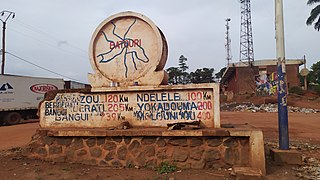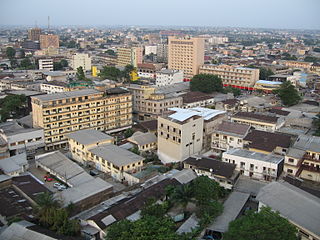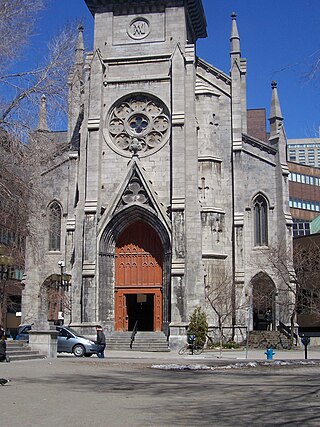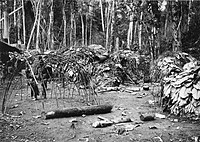
The Basilica of Our Lady of Peace is a Catholic minor basilica dedicated to Our Lady of Peace in Yamoussoukro, the administrative capital of Côte d'Ivoire. Guinness World Records lists it as the largest church in the world, having surpassed the previous record holder, Saint Peter's Basilica, upon completion. It has an area of 30,000 square metres (320,000 sq ft) and is 158 metres (518 ft) tall. However, it also includes a rectory and a villa, which are not strictly part of the church. It can accommodate 18,000 worshippers, compared to 60,000 for St. Peter's. Ordinary liturgies conducted at the basilica are usually attended by only a few hundred people. The basilica is administered by Polish Pallottines at a cost of US$1.5 million annually.

The East Region occupies the southeastern portion of the Republic of Cameroon. It is bordered to the east by the Central African Republic, to the south by Congo, to the north by the Adamawa Region, and to the west by the Centre and South Regions. With 109,002 km2 of territory, it is the largest region in the nation as well as the most sparsely populated. Historically, the peoples of the East have been settled in Cameroonian territory for longer than any other of the country's many ethnic groups, the first inhabitants being the Baka pygmies.
Articles related to Cameroon include:

Bouar is a market town in the western Central African Republic, lying on the main road from Bangui (437 km) to the frontier with Cameroon (210 km). The city is the capital of Nana-Mambéré prefecture, has a population of 40,353, while the whole sous-préfecture has a population of 96,595. Bouar lies on a plateau almost 1000m above sea level and is known as the site of Camp Leclerc, a French military base.

Nola is the capital of Sangha-Mbaéré, an economic prefecture of the Central African Republic. It is located at the confluence of the Kadéï and the Mambere river. The Sangha River is formed here due to the aforementioned rivers.

The Archdiocese of Montréal is a Latin Church ecclesiastical territory or archdiocese of the Catholic Church in Canada. A metropolitan see, its archepiscopal see is the Montreal, Quebec. It includes Montreal and surrounding areas within Quebec.
Marie-Thérèse Assiga Ahanda was a Cameroonian novelist, chemist, and paramount chief of the Ewondo and Bene people. Early in life, Ahanda worked for the Chemistry Department of the University of Yaoundé. She later moved to the Republic of the Congo with her husband, Jean Baptiste Assiga Ahanda, and took to writing. When they returned to Cameroon, Ahanda became an elected delegate in the National Assembly of Cameroon, a position she held from 1983 to 1988. Ahanda became the Ewondo paramount chief in 1999. In December 2000, she began renovating her father's palace at Efoulan, Yaoundé, a project that cost an estimated 150,000,000 francs CFA. Ahanda is the daughter of Charles Atangana—paramount chief of the Ewondo and Bene peoples under the German and French colonial regimes—by his second wife, Julienne Ngonoa.

The Roman Catholic Archdiocese of Douala is the Metropolitan See for the Ecclesiastical province of Douala in Cameroon. The current archbishop is Archbishop Samuel Kleda; he had previously been the coadjutor archbishop to the Archbishop Emeritus, Cardinal Christian Wiyghan Tumi.

The Diocese of Saint-Denis de La Réunion is a Latin Church ecclesiastical jurisdiction or diocese of the Catholic Church located on the island of Réunion. It is immediately subject to the Holy See. As such, it is not part of an ecclesiastical province, but is a member of the Episcopal Conference of the Indian Ocean. The cathedral church of the diocese is the Cathedral of Saint-Denis located in Saint-Denis.
The Roman Catholic Diocese of Yokadouma is a suffragan Latin diocese in the Ecclesiastical province of the Metropolitan of Bertoua in Eastern Cameroon, yet depends on the missionary Roman Congregation for the Evangelization of Peoples.
The Roman Catholic Diocese of Bafoussam is a diocese located in the city of Bafoussam in the Ecclesiastical province of Douala in Cameroon.

The Roman Catholic Metropolitan Archdiocese of Lille is an archdiocese of the Latin Church of the Roman Catholic Church in France.

Batouri is a town and commune in the East Province of Cameroon. It is the second largest municipality in the province after the provincial capital Bertoua. It is located on the main road connecting Bertoua to the Central African Republic and to the Cameroonian town of Yokadouma. It had an estimated 33,500 inhabitants as of 2012.

Douala is the largest city in Cameroon and its economic capital. It is also the capital of Cameroon's Littoral Region. Home to Central Africa's largest port and its major international airport, Douala International Airport (DLA), it is the commercial and economic capital of Cameroon and the entire CEMAC region comprising Gabon, Congo, Chad, Equatorial Guinea, Central African Republic and Cameroon. Consequently, it handles most of the country's major exports, such as oil, cocoa and coffee, timber, metals and fruits. As of 2015, the city and its surrounding area had an estimated population of 5,768,400. The city sits on the estuary of Wouri River and its climate is tropical.

Saint-Jacques Cathedral was the Roman Catholic cathedral in Montreal from 1825 to 1852, named for St. James the Greater. From 1825 to 1836, it was the seat of the auxiliary bishop of Quebec in Montreal. With the creation of the Roman Catholic Diocese of Montreal in 1836, it became the cathedral of the new diocese.

French Cameroon, also known as the French Cameroons, was a French mandate territory in Central Africa. It now forms part of the independent country of Cameroon.

The Chartres pilgrimage, also known in French as the pèlerinage de Chrétienté, is an annual pilgrimage from Notre-Dame de Paris to Notre-Dame de Chartres occurring around the Christian feast of Pentecost, organized by Notre-Dame de Chrétienté, a Catholic lay non-profit organization based in Versailles, France. Although the pilgrimage has existed since 1983, the organisation was not founded until 2000. There is also a pilgrimage in an opposite direction from Chartres to Paris called Pèlerinage de Tradition and organised by the Society of Saint Pius X.

The Our Lady of Peace Cathedral is the catholic cathedral of N'Djamena, capital of Chad and seat of the Archdiocese of N'Djamena. It is located near the Charles de Gaulle Avenue and Avenue Félix Éboué. It was built and inaugurated in 1965 and destroyed on April 21, 1980, during the Civil War. In fact, the city suffered great destruction in 1979 and especially in 1980, when the conflict developed commonly called the war "Tizah chuhur". The current building, which occupies most of the old structures, was rebuilt between 1983 and 1986. In 2013 it was restored again.
The following is a timeline of the history of the city of Yaoundé, Cameroon.
Marie-Reine Hassen, is an economist, diplomat and politician from the Central African Republic. She was one of the 17 wives of Jean-Bédel Bokassa, future Emperor of the Central African Republic, known as Bokassa I. She was a goodwill ambassador in Senegal from 2003 to 2006, Minister Delegate for Foreign Affairs from 2006 to 2007, Minister Delegate for the Economy, Planning and International Cooperation from 2007 to 2008, and then Minister Delegate for Regional Development from 2008 to 2009. She founded the Movement for Rallying and Change. She was a candidate for her country's 2010 presidential election.



















